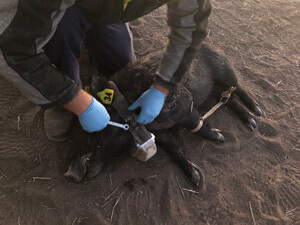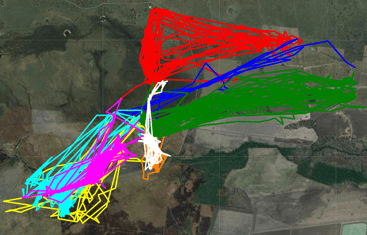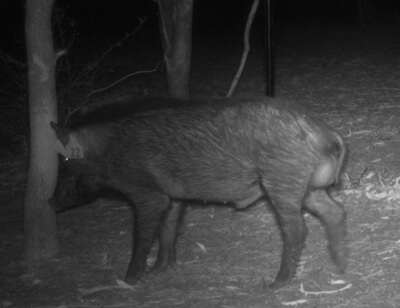Gwydir Valley Pest Management Initiative
Over the next 12 months the GVIA will be working in partnership with a range of organisations and local landholders to implement a
strategic feral pig management program. The program will involve monitoring feral pig populations and the damage they cause to natural
ecosystems and crops in and around the Gwydir wetlands. If you have seen pig damage in crop could you please complete the crop
monitoring form
and return to the GVIA
The project is being supported by funding from the NSW Government and the LLS under the NSW Regional Weed and Pest Animal Management Drought
Funding Program 2018-2019.
Feral pigs are an area wide issue, effective management of the pest on private and public land is important for the whole region. Control of
pig population growth is a priority for landholders and National Parks as they strive to manage the impact feral pigs have on native fauna
and flora as well as on grazing and cropping lands. The commitment to work together will ensure that we get the best results from the
project.
Project Progress
The project is now well underway. Since April there have been five recorded aerial shoots, with over 1,600 pigs controlled. Additionally, there has been an active program of trapping and baiting of pigs. All activities have been conducted by the National Parks and by private land holders. Despite the dry conditions the pig population is still significant, which means control will need to continue.

During August, the team from SQ Landscapes implemented a collar and camera monitoring program. Nine pigs were fitted with Global Positioning System (GPS) tracking collars. Since then one of those collared pigs was killed by the fire that was on the Gingham channel during September. Additional to the collars, a number of pigs were ear tagged.
 The
collars are showing the pig movements. There is clear evidence that the pigs are following consistent tracks as they move between water,
food and shelter. A couple of the pigs are not moving any great distances (white and orange), while others are moving noticeably further. As
temperatures increase pigs will need to wallow twice a day, this may further influence the movements of these pigs.
The
collars are showing the pig movements. There is clear evidence that the pigs are following consistent tracks as they move between water,
food and shelter. A couple of the pigs are not moving any great distances (white and orange), while others are moving noticeably further. As
temperatures increase pigs will need to wallow twice a day, this may further influence the movements of these pigs.

 The camera grid is monitoring pig numbers and movement. Ear tags are helping to identify specific pigs, providing greater insight into
individual pig movements. The aim of the grid design is to maximise both the number of cameras that individual animals are recorded on and
the number of individual animals that are recorded. Data from the cameras will give landholders a better understanding of abundance and the
effectiveness of control activities.
The camera grid is monitoring pig numbers and movement. Ear tags are helping to identify specific pigs, providing greater insight into
individual pig movements. The aim of the grid design is to maximise both the number of cameras that individual animals are recorded on and
the number of individual animals that are recorded. Data from the cameras will give landholders a better understanding of abundance and the
effectiveness of control activities.
The first round of control activities are being planned for mid October. The camera data will provide an understanding of the effectiveness
of this first round of control. Several weeks later a second round of control activities will be initiated, again the camera data will help
inform the success of this activity. All the data will be analysed and used to inform a strategic area wide control plan designed to
eradicate 80 to 90% of the pig population.
A huge thank you must go out to the landholders and National Parks who are working with SQ
Landscapes in this project, without their support none of this would be possible.
Key considerations in the management of Feral Pigs
- Feral pigs are everyones problem, just because you don't see them doesn't mean they are not there.
- An integrated area wide management approach will provide the best results for everyone.
- At least 80% of the population must be controlled.
- No single approach will be enough, a combination of aerial shooting, trapping and baiting needs to be employed across a wide area.
- Control activities need to be implemented year round, timing control solely on enterprise needs (eg seedling development) is unlikely to be enough.
- Pig movements are driven by the need for food, water and shelter, information suggests that they seem to return to shelter zones daily.
The project aims to enhance communication and develop integrated control strategies initiated in and around the internationally significant Gwydir Wetlands. Feral Pig impacts are exaserbated in dry times when the feral pigs tend to congregate around surface water sources.

The key partners in the project are the NWLLS, the National Parks, the OEH and local landholders.
For more information on the management of feral pigs visit the NSW Department of Industry website; the PestSmart website or NW LLS website.
